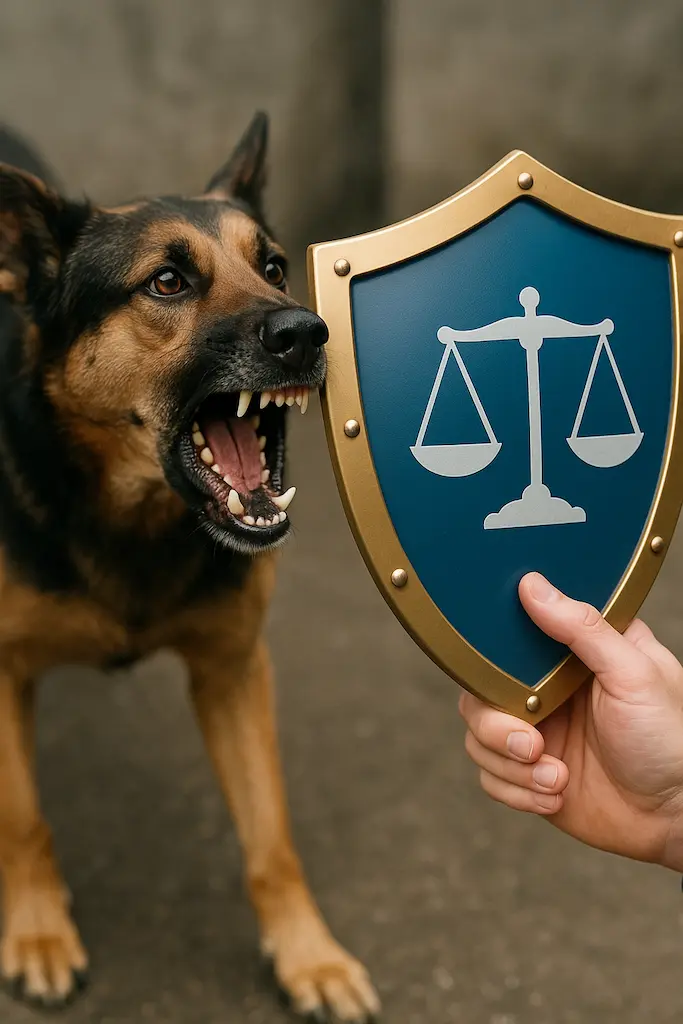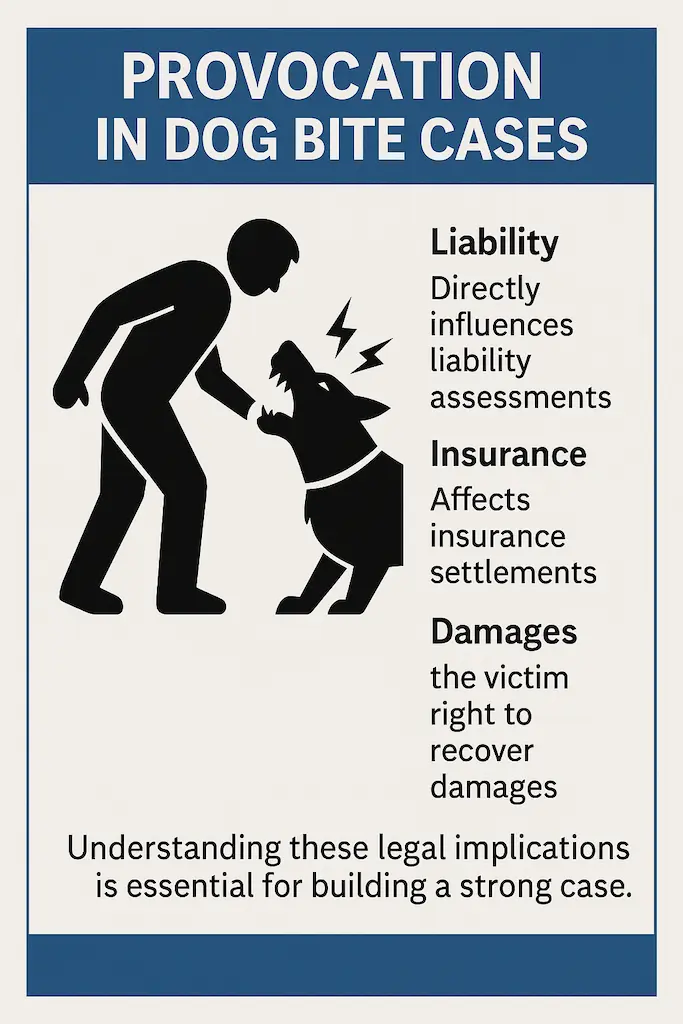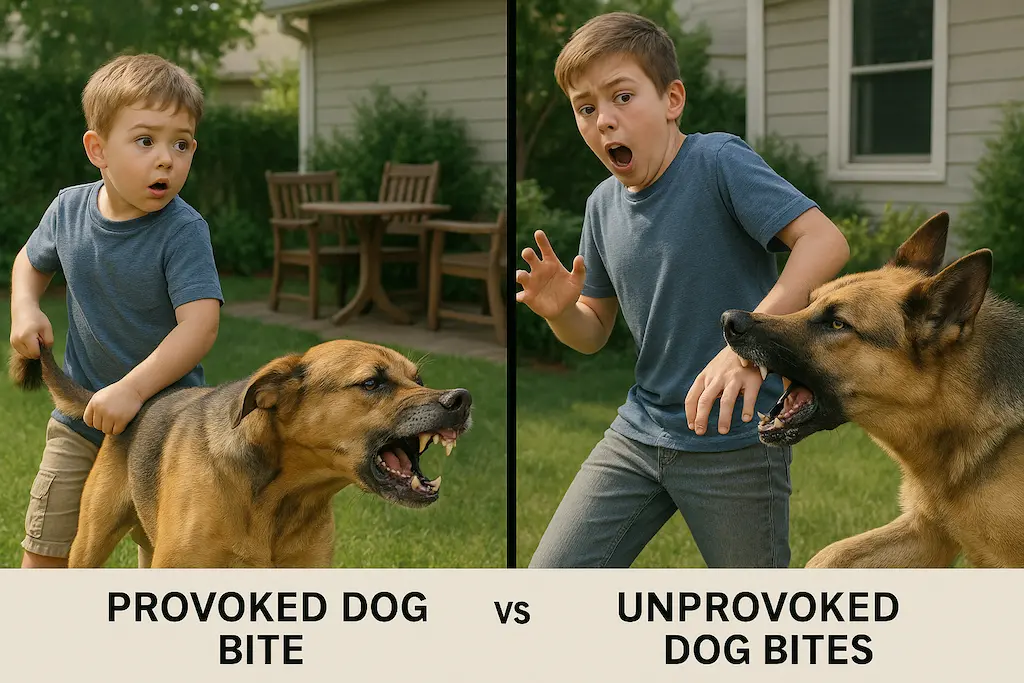Provoked bites have clear human triggers (pain handling, resource guarding, startling); unprovoked bites lack obvious triggers and raise greater legal and safety concerns
Legal liability differs significantly between provoked and unprovoked incidents
Key warning signs include stiffening, growling, whale eye, and avoidance behaviors
Prevention focuses on education, supervision, and recognizing canine stress signals
Unprovoked bites require immediate veterinary and behavioral evaluation
Dog bite incidents affect over 4.5 million Americans annually, with children representing 60% of victims. However, not all dog bites carry the same legal, medical, or behavioral implications. Understanding the critical distinction between provoked dog bites and unprovoked dog bites is essential for victims, dog owners, and legal professionals navigating liability, compensation, and public safety concerns.
Understanding the Difference Between Provoked and Unprovoked Bites
Provocation matters because it can determine whether your claim succeeds or fails.
In legal terms, a provoked dog bite occurs when the victim’s behavior triggered the dog’s aggression. An unprovoked bite happens without the victim doing anything to cause or encourage the attack.
Courts, insurance companies, and juries carefully examine the circumstances leading up to the incident to decide who bears responsibility.
What Counts as Provocation?
Provocation includes actions that reasonably trigger a dog’s instinct to defend itself.
This may be direct, such as hitting, teasing, or pulling a dog’s tail, or indirect, like stepping on the dog’s paw by accident. Even unintentional acts can be argued as provocation by a defense attorney.
Examples of provocation may include:
Physical Harm
Striking or physically harming the dog can trigger defensive behaviors and destroy trust between you and your pet.
Aggressive Communication
Teasing, yelling, or aggressively gesturing at the animal creates stress and can escalate into problematic behaviors.
Sudden Space Invasion
Entering a dog’s space suddenly, such as reaching for its food or puppies, can provoke protective and defensive reactions.
Accidental Harm
Accidentally hurting the dog (stepping on paw, tripping over it) can cause fear and make the animal more reactive to human movement.
This does not mean every interaction qualifies as provocation. Courts consider the reasonableness of the dog’s reaction. For instance, petting a calm dog in a park would rarely be seen as provocation.
What Counts as an Unprovoked Dog Bite?
Understanding the legal definition of an unprovoked dog bite is crucial for determining liability and seeking compensation. These incidents significantly strengthen a victim’s case as they demonstrate the dog’s aggressive behavior occurred without any reasonable cause or trigger.
Legal Definition and Importance
An unprovoked bite occurs when a dog attacks without any justifiable reason or threat from the victim. These cases are particularly significant because they clearly establish the dog owner’s responsibility and make it easier to prove negligence in court. The absence of provocation removes potential defenses that dog owners might use to reduce their liability.
Common Unprovoked Attack Scenarios
Unprovoked dog bites typically happen in everyday situations where victims are going about their normal activities:
- Street Encounters: A passerby being bitten while simply walking down the street, jogging, or riding a bicycle without any interaction with the dog.
- Property Incidents: A child attacked in a neighbor’s yard without touching, approaching, or even acknowledging the dog’s presence.
- Service Situations: Delivery drivers, mail carriers, or utility workers bitten while performing their duties, such as leaving packages at doors or reading meters.
- Public Spaces: Visitors to parks, beaches, or other public areas attacked without warning while maintaining appropriate distance from the animal.
Legal Advantages for Victims
In unprovoked bite cases, several factors work in the victim’s favor:
- Dog owner liability is more straightforward to establish
- Compensation for medical expenses, lost wages, and pain and suffering is more attainable
- Insurance companies are less likely to dispute claims
- Legal precedent strongly favors victims in unprovoked attacks
If you’ve been the victim of an unprovoked dog bite, documenting the circumstances and seeking immediate legal counsel can significantly impact the outcome of your case.

Photo representing legal protection against unprovoked dog attacks

Scales of justice illustrating the balance between victim rights and provocation factors in dog bite cases
Why Provocation Matters in a Dog Bite Claim
The concept of provocation serves as a critical determining factor in dog bite litigation, directly influencing liability assessments, insurance settlements, and the victim’s ultimate right to recover damages. Understanding these legal implications is essential for building a strong case.
Direct Impact on Legal Outcomes
Provocation doesn’t just influence your case—it can fundamentally alter the entire legal landscape. Courts and insurance companies scrutinize every detail to determine whether the victim’s actions contributed to the incident, making this factor pivotal in determining both liability and compensation amounts.
Owner Liability Considerations
State Law Variations
Strict Liability States: Many jurisdictions have enacted comprehensive laws stating that dog owners bear no legal responsibility when evidence proves the victim provoked the animal through intentional or reckless behavior.
One-Bite Rule States: These states require proof of the dog’s previous dangerous behavior, but provocation can still eliminate owner liability even with prior knowledge of aggression.
Comparative Negligence Framework
Fault Distribution System
Pure Comparative Negligence: States following this rule reduce your compensation proportionally to your degree of fault. Even if you’re 90% responsible, you can still recover 10% of damages.
Modified Comparative Negligence: Some states bar recovery if your fault exceeds 50% or 51%, making provocation allegations particularly dangerous to your case.
Insurance Defense Strategies
Insurance companies representing dog owners commonly employ provocation as their primary defense mechanism. Their tactics include:
- Immediate Investigation: Insurance adjusters quickly gather evidence to establish any possible provocative behavior
- Witness Interviews: Comprehensive questioning of witnesses to uncover actions that might be construed as provocation
- Expert Testimony: Hiring animal behavior specialists to testify about how specific actions might provoke dogs
- Video Analysis: Frame-by-frame examination of security footage to identify potentially provocative gestures or movements
Real-World Financial Impact
Compensation Calculation Example
This 30% reduction represents a significant financial impact that could affect medical treatment options, lost wage recovery, and long-term financial stability.
Strategic Legal Considerations
Given the substantial impact of provocation allegations on case outcomes, it’s crucial to work with experienced legal counsel who can effectively counter these defenses. Early documentation of the incident, witness statements, and expert analysis can help protect your rights and maximize your compensation potential.
The Role of Evidence in Proving Provocation or Lack Thereof
Evidence is critical in showing whether the bite was provoked or unprovoked.
Strong evidence includes:
Medical Documentation
Comprehensive medical records serve as the cornerstone of your legal case. These include emergency room reports, physician notes detailing wound severity, treatment protocols, prescription records, and follow-up care documentation. X-rays, MRI scans, and photographs taken by medical professionals provide objective evidence of injury extent. Psychological evaluation records documenting trauma, PTSD, or anxiety resulting from the attack also strengthen your claim significantly.
Witness Testimonies
Eyewitness accounts provide crucial third-party perspectives on the incident. Collect detailed statements from neighbors, passersby, postal workers, or anyone present during the attack. Document their contact information, exact location during the incident, and timeline of events. Written statements should include the victim’s behavior before the bite, the dog’s demeanor, owner’s presence or absence, and any verbal exchanges. Video testimonies can be particularly compelling in court proceedings.
Photographic & Video Evidence
Visual documentation creates powerful, undeniable evidence for your case. Immediately photograph all visible injuries from multiple angles, showing progression of healing over time. Document the attack location, including property conditions, fencing, signage, and potential hazards. If available, security camera footage from nearby businesses or homes can provide objective proof of the incident. Photos of the dog’s size, breed characteristics, and aggressive behavior patterns help establish the animal’s dangerous propensities.
Official Documentation
Filing official reports establishes a legal paper trail essential for your case. Contact animal control immediately to document the incident, request inspection of the property, and initiate investigation procedures. Police reports provide official incident documentation with badge numbers and case references. Obtain copies of any prior bite reports involving the same dog, which establish a pattern of dangerous behavior. Health department rabies investigation records and veterinary examination reports also contribute valuable official evidence.
Your attorney will use this evidence to prove the bite was unprovoked and strengthen your dog bite claim.
How States Handle Provoked Dog Bites Differently
The legal landscape surrounding dog bite liability varies dramatically across the United States, creating a complex patchwork of laws that significantly impact both victim rights and owner responsibilities. Understanding your state’s specific approach to provocation is crucial for determining the strength of your case and potential compensation.
Three Primary Legal Frameworks
American jurisprudence has evolved to encompass three distinct approaches to dog bite liability, each treating provocation allegations with different levels of scrutiny and legal weight.
Strict Liability States
Majority of StatesCore Principle: Dog owners bear automatic responsibility for bite incidents, regardless of the animal’s previous behavior or the owner’s knowledge of potential danger.
Key Characteristics:
- Burden of Proof: Owners must prove clear provocation to escape liability
- No Prior Knowledge Required: First-time aggressive incidents still trigger owner responsibility
- High Provocation Standard: Courts require substantial evidence of intentional victim misconduct
- Victim Protection: Strongest legal protection for bite victims
One-Bite Rule States
Traditional ApproachCore Principle: Owners escape liability unless they had prior knowledge of their dog’s aggressive tendencies or the victim can prove negligent handling.
Legal Requirements:
- Prior Knowledge Proof: Victims must demonstrate owner awareness of danger
- Provocation Defense: Easier for owners to claim victim provocation
- Negligence Standard: Focus on owner’s reasonable care obligations
- Historical Approach: Traditional common law methodology
Comparative Fault States
Mixed ApproachesCore Principle: Courts distribute fault percentage between victim and owner, with compensation reduced proportionally to the victim’s degree of responsibility.
Fault Distribution Methods:
- Pure Comparative: Compensation reduced by exact fault percentage
- Modified Comparative (50% Rule): No recovery if victim is 50% or more at fault
- Modified Comparative (51% Rule): No recovery if victim exceeds 51% fault
- Detailed Analysis: Extensive investigation of all contributing factors
Critical Implications for Your Case
Evidence Requirements
Different states demand varying levels of proof for provocation claims, affecting your documentation strategy and witness preparation.
Compensation Variations
Your potential settlement or jury award can vary dramatically based solely on your state’s legal framework and provocation standards.
Case Timeline
Strict liability states often resolve cases faster, while comparative fault jurisdictions require extensive fault analysis.
Legal Strategy
Your attorney’s approach must align with your state’s specific precedents and statutory requirements for optimal results.
The Importance of Specialized Legal Counsel
Given the dramatic variations in state law approaches to dog bite liability and provocation defenses, consulting with an attorney who specializes in your jurisdiction’s specific legal framework is not just recommended—it’s essential for protecting your rights and maximizing your recovery potential.
What Specialized Attorneys Provide:
🚨 Time-Sensitive Legal Protection
Statute of limitations varies by state (typically 1-6 years), and evidence preservation becomes critical immediately after an incident. Don’t let valuable time pass—consult qualified legal counsel promptly to protect your rights under your state’s specific legal framework.
Dog Bite Law Overview
Understanding legal framework differences
Strict Liability
Most CommonAutomatic owner responsibility
One-Bite Rule
Traditional ApproachPrior knowledge required
Comparative Fault
Mixed ApproachesShared responsibility model
⚖️ Important Legal Notice
State laws are complex and constantly evolving. Many jurisdictions use hybrid approaches combining elements from multiple frameworks.
Always consult with a qualified attorney in your specific state for accurate, up-to-date legal information.
Key Statistics
The Human Side: Why Courts Consider Provocation Carefully
Dog bite law tries to balance victim rights with fair treatment of dog owners.
Judges and juries understand that dogs can act defensively, but they also recognize that victims face serious physical injuries, emotional trauma, and medical costs.
By examining provocation carefully, courts aim to protect responsible dog owners from unfair blame while ensuring that victims of unprovoked attacks get justice.
When to Call a Dog Bite Lawyer
You should contact a lawyer immediately if your case involves questions of provocation.
An attorney can:
- Collect and preserve critical evidence for your claim.
- Challenge false provocation arguments from insurers.
- Calculate full dog bite damages, including medical bills, lost wages, pain, and suffering.
- Represent you in out-of-court settlements or at trial.
Legal deadlines, called statutes of limitations, vary by state. Waiting too long can forfeit your right to file a claim.
Key Takeaway
Provoked vs. unprovoked bites can make or break your case.
If you did nothing to provoke the dog, your claim is stronger and you may recover full compensation. If the defense argues provocation, you’ll need strong evidence and a skilled dog bite lawyer to fight back.
Frequently Asked Questions About Dog Bite Provocation Claims
Get expert answers to critical questions about provocation defenses, legal rights, and how to protect your claim
Understanding Legal Definitions of Provocation
Quick Answer: Provocation means any behavior—intentional or not—that could reasonably trigger a dog’s aggressive reaction.
Provocation encompasses a broad spectrum of human behaviors that courts may consider as potential triggers for dog aggression. The legal standard varies by jurisdiction, but generally includes both intentional and unintentional actions.
🎯 Intentional Provocation
- Physical aggression: Hitting, kicking, throwing objects at the dog
- Verbal antagonism: Yelling, screaming, or making threatening gestures
- Deliberate harassment: Teasing, taunting, or cornering the animal
- Territory invasion: Entering the dog’s space aggressively
⚠️ Unintentional Provocation
- Startling actions: Sudden movements, loud noises, unexpected contact
- Accidental injury: Stepping on the dog’s tail or paws
- Protective responses: Reaching for the dog’s food, toys, or puppies
- Medical procedures: Attempting first aid or moving an injured dog
📋 The “Reasonable Person” Legal Test
Courts apply the “reasonable person standard”: Would your actions have reasonably caused a typical dog to react aggressively? This objective test considers:
Building an Ironclad Unprovoked Attack Case
Quick Answer: Document everything fast—photos, witnesses, medical records—and create a clear timeline of peaceful conduct; the owner/insurer typically bears the burden to prove provocation.
Proving lack of provocation requires comprehensive documentation and strategic evidence collection. Success depends on creating a clear timeline that demonstrates your peaceful conduct leading up to the attack.
🚨 Immediate Actions (First 24 Hours)
Capture your injuries, torn clothing, blood evidence, and the exact location where the attack occurred
Seek immediate professional treatment to create official medical records of your injuries
Collect contact details and written statements from anyone who witnessed the incident
File police reports and animal control complaints to create government documentation
📝 Follow-up Evidence Collection (First Week)
Understanding Compensation Under Comparative Fault Systems
Quick Answer: Yes—most states allow recovery under comparative negligence; your payout is reduced by your percentage of fault.
Yes, in most jurisdictions you can still recover substantial damages even if found partially responsible for provoking the attack. The key lies in understanding your state’s specific approach to shared fault.
Pure Comparative Negligence
13 StatesRecovery Rule: You can recover damages even if you’re 99% at fault
💰 Example:
Modified Comparative (50% Rule)
23 StatesRecovery Rule: Recover if you’re 50% or less at fault
💰 Example:
Modified Comparative (51% Rule)
12 StatesRecovery Rule: Recover if you’re 51% or less at fault
💰 Example:
🎯 Maximizing Your Compensation Strategy
Understanding Insurance Company Defense Strategies
Quick Answer: Insurers push provocation to cut payouts; your rights include fair evaluation, evidence preservation, and the ability to counter with counsel.
Insurance companies routinely deploy provocation claims as their primary defense strategy because it’s often their most effective tool for reducing or eliminating payouts in dog bite cases.
🏢 Common Insurance Company Tactics
Financial Motivation
The Numbers Game: Dog bite claims cost insurers over $850 million annually. Provocation defenses can reduce this liability by 30–70% per claim.
Psychological Pressure
Victim Blame Strategy: Guilt and uncertainty drive lower settlements.
Legal Maneuvering
Defense Strategy: Even weak provocation claims cost time and money to refute.
🛡️ How Legal Representation Counters These Tactics
Secure witnesses, video, and medical records immediately
Lawyers handle insurers to avoid harmful statements
Access to experts and investigators
They know true case value and push back
Strategic Timing and Legal Process Expectations
Quick Answer: Contact an attorney within 24–48 hours to preserve evidence and protect your rights; most offer free, no‑obligation consultations.
The timing of legal consultation can dramatically impact your case outcome. Understanding when and why to contact an attorney—plus what to expect during the process—ensures optimal protection of your rights and maximum compensation potential.
🚨 Critical Timing Windows
Immediate Contact (Within 24–48 Hours)
CRITICALWhy This Timeline Matters: Evidence disappears quickly, and insurers move fast to secure self‑serving statements.
- Security footage may auto‑delete within 30 days
- Witness memories fade rapidly
- Scene evidence gets disturbed
- Medical documentation needs coordination
- Avoid harmful statements
- Stop early lowball tactics
- Ensure proper records from the start
- Counter provocation narratives
Early Consultation (First Week)
IMPORTANTStrategic Advantages: Still time to secure crucial evidence and set a strong foundation.
Delayed Contact (After One Week)
CHALLENGINGIncreased Difficulties: Possible to build a case, but with reduced leverage.
- Provocation = any behavior that could reasonably trigger aggression (even unintentional).
- Act fast: preserve evidence, get medical records, and collect witnesses within 24–48 hours.
- You can still recover with partial fault under comparative negligence; lawyers counter insurer tactics.

